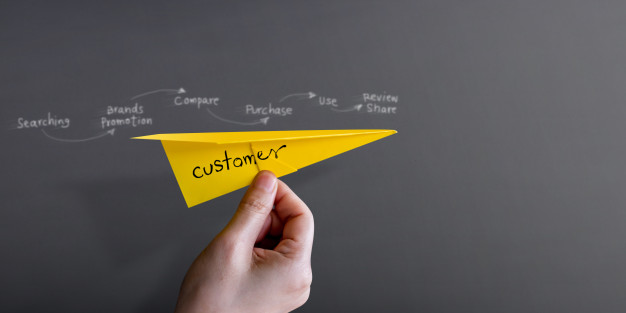Customer lifecycle marketing is being aware of where your customer is in the life cycle of using your product. Then, providing proper messaging when and where they want and need the information, at the right time. Always asking yourself questions about what your customer needs, what phase they are in, and looking through your customer’s perspective are key requirements when implementing customer life cycle marketing for your business.
Learning the stages of customer life cycle marketing will help you boost sales and increase your customer retention rates. Read on to find out how you can optimize every client interaction and create less turnover.
What is Customer Lifecycle Marketing?
Customer Lifecycle marketing is a marketing tactic that nurtures your client through the entire journey. This is the journey when clients start from being a potential customer to a loyal customer. Marketers use this concept to improve customer retention and increase brand loyalty amongst their clientele. Each phase of customer lifecycle marketing highlights what you should focus on and what is important to the consumer in that specific stage in order to get the best outcome. You want to get the best results in each phase and keep the customer moving through all the phases to eventually become a brand loyal customer. Knowing what customers look for and need in every phase of the customer’s lifecycle can help you boost sales and create a large consumer base.
Lifecycle Marketing Phases:
1. Awareness
The first phase is the start of your company’s relationship with your customer. This is when your customer first becomes aware of your brand via different advertising methods. This is an important phase because knowing the way you earned your customers helps you focus on the marketing tactic that gives you the least turnover. Some of the ways to acquire a new customer in the brand awareness phase are:
- Emails
- Print Ads
- Social Media
- Website Banner Ads
- Video Ads
- TV Commercials
- Word of Mouth
- Sound Ads
It is important to create your ads in a way that is easily read, pleasing to the eye, or easy to hear. Incorporating humor into your ads can be an effective strategy. Using wordplay or short, fun videos featuring your product or service has been known to create a buzz in order to become more memorable to your target audience. Your ads should be direct and to the point to increase brand awareness. Your advertisements should answer a few questions in order to get your message across. These questions include:
- Who are you and what is your product or service?
- Why should potential customers care?
- What problems is your audience facing?
- How can your product/service fix your audience’s problems?
- What is the outcome for potential customers if they act or don’t act?
2. Engagement
Your marketing tactics can be most effective in the engagement phase. This is because it gets your potential client to interact with your company firsthand. Creating that communication and engagement with your customers in order to connect with them opens a new avenue of marketing, by becoming more personal with your clients. By creating engagement, your customers will know more about your product and are more likely to buy it, but they have questions. These questions can include:
- How does your product/service work?
- How do you use the product/service?
- What are your specials/deals now or upcoming?
- What are some additional features?
Questions from your customers are good and answering them is even more important. Additionally, this creates a relationship with your audience and builds brand loyalty which will grow your sales.
If your company is not getting a lot of engagement from your customers, then create it. There are many fun and interactive ways to create engagement between you and your audience which can boost your customer retention. Some of the ways you can create engagement are:
- Engage on social media: Nowadays nearly everyone in all age groups is active on social media, which means this is a prime platform for you to communicate with them. Furthermore, Being active and responsive in a timely manner to your social media followers allows prospects and clients to feel that you care about them.
- Offer surveys and polls: This is a fun way to create engagement while also learning about what your customers expect and need from your company
- Call to Actions: Utilizing a call to action on your ads or social media is also an effective way of creating engagement. Using phrases like “ask now” or “contact us today” make your company seem more approachable in order to get people to engage.
3. Evaluation
The evaluation phase is when your potential customers are considering buying your product or service and comparing your brand to other competing brands. This is where customers will begin researching your business, reading reviews, and comparing it to others on the market. This is why your digital platform with all your product/services information needs to be properly developed. Specifically, your website. All the information about your products or services needs to be available, organized, and easy to read.
Additionally, Providing your customers with the information they want to know about your product in a simple easy to read way is a great way to stand out from your competition. Some of the things that should be present on your digital platforms are:
- All your products, including features, sizes, colors, and formats
- All risks or issues with using the products/services
- Any add-on that can improve or benefit their purchase
- Any specials or deals you currently provide
- How you solve your customer’s issues with your products/services.
Make sure you write good descriptions of your products and services on your website. This helps improve conversion rates and can also increase sales.
4. Purchase
The next phase is the purchase phase, which of course is one of the most important phases because this is when your customer will be paying for your products or services. When it comes to the purchase phase, you need to make it as seamless and easy as possible for your customer to buy from you. Furthermore, the easier the experience your customers have, the more likely they will be a repeat buyer. Features that can make the buying process easier for your customers include:
- Make sure your site is mobile-friendly
- Have an App option
- Save Customer information for faster purchase feature
- Always include high-quality images and descriptions
- Live Chat Customer service
- FAQ page
- Provide product reviews
5. Customer Retention
After the purchase has been made by your customer, the next thing is making sure they come back for more. Building brand loyalty with your clients is essential to a successful business. When you create brand loyalty with your customers, they will then talk about your business to their friends, family, and peers, and through word of mouth advertising your business will grow. You can build brand loyalty by nurturing the relationship with your clients and thereby building trust by making your clients feel special. Additionally, Some great ways to build brand loyalty and increase customer retention include:
- Engaging on social media: Customers want to know you care, and by answering questions and comments on social media can show that.
- Manage complaints and review: Responding to complaints and reviews quickly and professionally shows you care to the person making the comment, as well as others that are reading how you handle problems with your clients. Good or bad, you should respond professionally to all relevant comments.
- Loyalty programs: by offering loyalty programs, it gets your customers involved and shows you value repeat business by rewarding repeat business.
- Utilize texting services: SMS text advertising is a cost-effective and direct way to communicate with your customers instead of having them call a phone number. The convenience will impress your clients and build customer retention.


